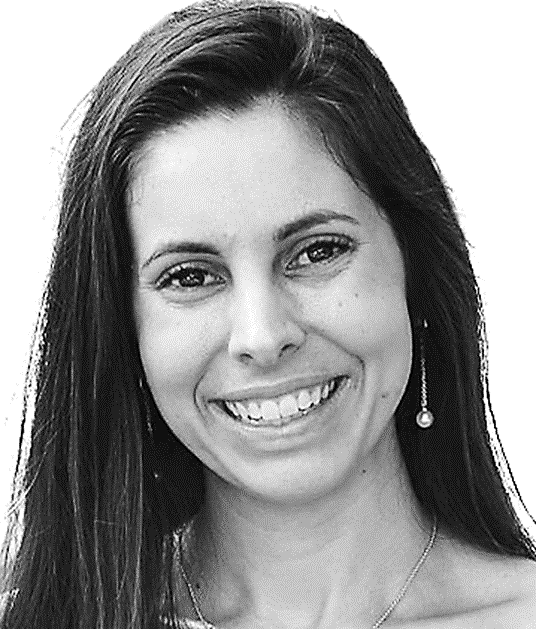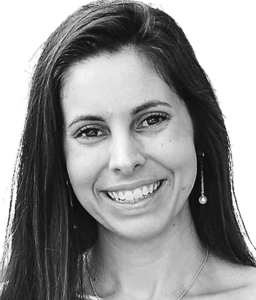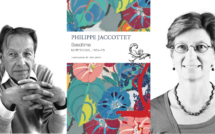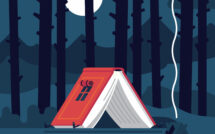
Refugees’ Oral Histories and Community Education: An Interview with Katherine Clifton

This is part of our roundtable, Forced Migration.
From 2018 to 2023, Katherine Clifton was the Coordinator of the Religion & Forced Migration Initiative (RFMI) at Princeton University, a project funded by the Henry Luce Foundation and hosted by Princeton’s Office of Religious Life. The RFMI aims to better understand and respond to the role religion plays in the lives of refugees as they resettle and integrate into the United States. The RFMI’s view is that questions of religion have been absent from our shared public, civic, and scholarly knowledge about resettlement. Understanding the religious and spiritual life of refugees and refugee communities is critical to grasp their experiences, and enabling refugees to share their personal stories is a way to learn about these experiences.
The RFMI has responded to the inadequate understanding of religion as an element of migration experiences by assembling an archive of refugee oral histories and creating corresponding pedagogical materials; it has also collated relevant resources and connected scholars, practitioners, and those most impacted by forced displacement through regular convenings. The RFMI has pursued this work to strengthen refugee services and the resettlement structure at large, build a supportive network of stakeholders, and center the voices of refugees in our current moment. People involved in the RFMI describe their efforts as a form of civic engagement, public scholarship, and public religion. In this conversation with the Consortium on Forced Migration, Displacement and Education, Katherine Clifton elaborates on why religion is so central to an understanding of refugees’ experiences and the ecosystem of resettlement. She describes the origins, aims, and core projects of the RFMI, explains how her own trajectory led her to work on refugee issues, and discusses approaches for future work in this field.
—Kirsten Wesselhoeft for EuropeNow
EuropeNow You coordinated the Religion & Forced Migration Initiative (RFMI) at Princeton University until the program ended in 2023. Why do you think accounting for religion is important to an understanding of forced migration; and vice versa, why is studying forced migration key to an understanding of religious life today? How does the RFMI engage with these topics?
Katherine Clifton People often ask me, “did you come to this work from your interest in religion or from your interest in resettlement?” I definitely came to it from my work with refugees, thus from the resettlement angle. However, I have always been fascinated with religion. Historically, the US refugee resettlement system has depended on the goodwill of people of faith and on faith-based organizations. The US resettlement program started after the Second World War, when Christians and Jews welcomed into the US people sharing their faith. Later, these efforts were expanded to include people of various other faiths.
The RFMI project was born out of a recognition that religion is understudied and generally overlooked socially. A central premise of the project is that religion matters to enhance refugees’ mental health, to foster civil society, and for secular and religious partners to participate in the resettlement system. We do not try to say that religion is good or bad. Religion does not live in a particular person or place of worship but works across and within communities, universities, and institutions. It plays a critical role in the public sphere; we think that faith leaders are crucial to building communities and that faith communities strengthen society. Therefore, we want to study, amplify, and engage in the intersection of religion and resettlement. From our vantage point, this approach itself becomes almost a form of public religion.
EuropeNow What were the original goals of the RFMI initiative? In particular, how did the idea of creating an archive of refugees’ stories with corresponding pedagogical material emerge?
Katherine Clifton We wrote the creation of an archive into the grant in 2018. We wanted to conduct an oral history project, establish an online archive, and make that archive open access. Teaching material was not mentioned anywhere at that time, but the idea of using the archive in the classroom came from realizing that oral history archives are plentiful but unfortunately often unheard. Thus, we were determined to “activate” the archive, so that it would not only exist online but would actually be experienced by the public. Because we were based at a university and many of our students were interested in education, we thought we would create content, visual aids, and other material for the website to turn it into a teaching resource. Then we started talking with teachers; many of them already taught a unit on migration in their classes and said they would very much like to include some first-person accounts. They also wanted their students to do primary source research through our archive. Those conversations led us to develop, alongside teachers, week-long lesson plans as well as maps and other learning materials, which we placed on the website for anyone to use.
EuropeNow Before joining the RFMI, how did you first come to study migration and displacement?
Katherine Clifton I was born and raised in Honolulu, Hawaii—a welcoming place. After high school, I wanted to do a gap year and get far away from Hawaii because, as much as I loved it, it felt removed from the rest of the world. I applied to Princeton University and was accepted into the Novogratz Bridge Year Program, a sponsored gap year program that students attend before matriculating at Princeton. The program allowed students to spend the year in different locations, one of them being Serbia. I had read Samantha Power’s book, A Problem From Hell, about the genocide in Bosnia, and learned about the Roma as a group of forced migrants. So, I wanted to work with the Romani people and teach them English, which is what I did before starting at Princeton.
After graduating from Princeton in 2015, I returned to Serbia to work with the Roma again. Since I was last in the country, there had been a massive influx of refugees, mostly from Syria but also other parts of the Middle East and Northern Africa. Thus, I became involved in aid efforts at refugee camps. I then attended graduate school at the University of Oxford’s Refugee Studies Center to gain formal academic training in refugee studies, which I did not have. Once there, I pivoted from the humanities to the social sciences, spending one year at the Refugee Studies Center and one year pursuing a public policy degree. Later, I heard that Princeton, my alma mater, was seeking a grant to support research on the role of religion in refugee resettlement in the US. In 2018 I began working on the grant, which became the Religion & Forced Migration Initiative.
EuropeNow As the RFMI program’s coordinator, what has been your experience orchestrating such a large collaborative initiative? In particular, how did you seek participants for the oral history component of the project?
Katherine Clifton The Princeton Office of Religious Life is devoted to the building of relationships rooted in trust and care; therefore, many of our partnerships have emerged organically out of acquaintances. We obtained the grant in the first place because our office had organized an international and interdisciplinary academic conference at Princeton in 2017—“Seeking Refuge”—in partnership with the International Rescue Committee and the United States Conference of Catholic Bishops, two of the main resettlement agencies in the US. The conference substantially emphasized practitioners—not only scholars—who were interested in the role religion plays in forced migration. The event drew attention to the importance of speaking about religion in the conversation about migration.
Another component of our activity is the “Asylum Project,” where undergraduate students at Princeton select area specialists—mostly Latin Americanists—whose work focuses on those places from which many asylum seekers in the US come. Then, together, scholars and students write expert affidavits to be added to the applicants’ asylum cases. This experience is valuable for students and can be impactful for asylum seekers. While this project emerged out of our partnership with The Catholic Charities of the Archdiocese of New York, it is not based on religion per se. However, it has resulted from the coming together of a faith-based organization and the Office of Religious Life.
As part of the project, undergraduate students were brought in to serve as interviewers in the collecting of refugee oral histories. Most students have heard about forced migration from the news, since people are constantly being resettled, sometimes even into students’ own local communities. Moreover, many of our students have come from different countries around the world, have refugee backgrounds themselves, or are part of families with stories of migration, which provides various entry points to get them curious about the intersection of religion and resettlement. Hence, we had no trouble recruiting students to do research with us. The most challenging part of this work was to identify narrators for the oral histories. It can be difficult to develop trust and get people to recognize that it is worth their time to participate; it is not easy for them to believe that we will treat their stories honorably. Moreover, many people identify as refugees in the US, but without efficient connections it is hard to access them. There is also a risk of essentializing them based on that one part of their lives. Nevertheless, we have been able to record over 180 interviews for our archive so far, and over 100 students have been involved.
EuropeNow What methodology do the interviewers use when collecting oral histories from migrants or refugees? More generally, what are some specific strategies and practices used when engaging with them?
Katherine Clifton Sometimes, people do not trust us because they have been taken advantage of before by other interviewers, usually journalists. However, we tell participants ahead of time about our three “commandments.” First, we aim at making them feel that, as narrators, they lead the interview and are in control of it. For example, they can end it, pause it, refuse to answer a question, or even later retract something they already said. We also give them the chance to review the transcript—although few interviewees have done this, a couple have. This procedure is not typical when conducting oral histories; but it is our way of being kind and get people to trust the project. Second, we ask open-ended questions to make people comfortable and hopefully inspire them to share and reflect on their experiences in ways they may not have thought about. We seek to open new channels for them to share their story. Third, we generate questions out of what the participants say, for example following up about a specific word they used, or a place or a person they mentioned. Nevertheless, our interviews remain imperfect, and the process can sometimes be awkward.
We also talk to the participants briefly beforehand to know where they have come from and brainstorm topics they would like to speak about. We also ask them if there is any question we should or should not ask. We then do research about their countries of origin. Oral histories entail front-loaded work to ensure the interviewers are ready for the interviews. To build trust, we also provide examples of oral histories we have recorded before. We tell participants we will provide them with the transcripts, recordings, and outlines. Participants can also request that we place their oral histories in any other archival repository, such as that of a historical society, a mutual aid group, or an organization based on the ethnic group with which they identify. Many narrators in our archive participated in order to preserve the history of their families. Moreover, the experience can be empowering for them, because they can see that their story is theirs to tell and that others in their communities will be able to learn from it in the future. Giving refugees an open space to share all they want about themselves is part of our overall mission, which is to change the discourse about refugees and change public opinion.
EuropeNow You mentioned earlier here that the RFMI aims to “activate” this archive for different audiences in various educational systems? How does the RFMI vary its approaches depending on the pedagogical contexts?
Katherine Clifton The RFMI has worked with public and private schools, including a variety of religious schools—of Muslim, Jewish, and different Christian denominations. It caters to those different educational systems in much the same way. However, it does also tailor the material to specific settings. As an example, it integrated Catholic social teachings in the lessons created in partnership with the Cristo Rey Network—a Catholic organization. This material would not have been used when working with our Muslim partner school. In the later case, we featured a greater number of Muslim narrators in the lesson, because instructors at that school wanted to focus on lived religion through Islam.
The RFMI is guided by a few values that work across the board, and its approaches remain the same whether the content is created for a history class or an English class. We also listened to our educational partners, since they know the needs of their classes, their students, and their communities at large better than we do. We have also worked with education departments at resettlement agencies and people who raise awareness in their communities about the populations coming into their towns. When there were many Afghans arriving in the US, we developed a lesson plan that provided background information about them, along with pertinent excerpts from our archive. The purpose of the RFMI is always to advance the understanding of refugees’ experiences—as told in their own words—amplify refugees’ voices, and increase empathy about refugees’ lives and public awareness. That is what motivates all of the lesson plan building. The RFMI does not aim to politicize the issue and instead lets the archive speak for itself. However, although it does not use the archive as an overt advocacy tool, that goal is implicit in parts of the teaching materials it produces.
EuropeNow What is next for the Religion & Forced Migration Initiative? What have been some broader impacts of your work so far?
Katherine Clifton We ended the program at the end of the 2023 academic year, but we want to continue to honor our commitments. Thus, we will continue to grow the archive and develop curricula. Some of our partnerships are still ongoing, such as the Asylum Project. We will be incorporating some new dimensions too. I love theater, and I am working on a documentary play with one of the project’s alumni that uses interviews and direct testimony in some scenes. We are trying to think of creative ways to continue to activate the archive. In terms of overall takeaways, many issues around the world, nationally, or in our local communities, emerge because people do not listen to each other. It is hard to deeply, empathically, and attentively listen to people; it is not a competence that is privileged in school. Oral histories can promote this skill. The archive we created encourages me—and I hope the students who worked on it—to listen better in other contexts as well. Hopefully, people will continue to engage with our project. I hope it can help wider audiences appreciate the variety of experiences that refugees have and encourage these audiences to be more welcoming, to get involved with refugees in whatever way makes sense to them, and to collectively make society a better place.
EuropeNow Finally, what suggestions do you have for people involved in projects based on multifaith collaborations in the context of migration? What do you hope they might take away from your archival project?
Katherine Clifton To not overlook religion is a good place to start. It is necessary to really listen to people, really listen to refugee stories, always include their voices, and centralize them. People interested in this work should reach out to a variety of organizations, which they may not have thought about working with before, to transform colleges and universities into thriving, compassionate, service-oriented organizations. Including a variety of stakeholders in your network makes the overall impact much richer for everyone involved.
Katherine Clifton pursued master’s degrees in refugee & forced migration studies and public policy at the University of Oxford as a Rhodes Scholar from 2016 to 2018. She then returned to Princeton University, where she had received her BA in English in 2015 with a minor in theatre, to lead the Religion & Forced Migration Initiative. In 2023, she became the Assistant Director of Communications for the Department of Migration & Refugee Services at the United States Conference of Catholic Bishops in Washington, D.C.
Kirsten Wesselhoeft is Assistant Professor of Religion at Vassar College, where she also teaches in the Africana Studies, International Studies, and Women, Feminist, & Queer Studies programs. She is the principal investigator and Faculty Director of the Consortium on Forced Migration, Displacement and Education. She is the author of Fraternal Critique: The Politics of Muslim Community in France, forthcoming from The University of Chicago Press.
Sam Cavagnolo graduated from Vassar College (class of 2022) where she studied religion & migration and displacement studies. Since July 2022, she has been the Coordinator for Research and Pedagogy with the CFMDE.
Arlene Chen is a student at Vassar College (class of 2024) studying history and migration & displacement studies. She has previously worked on the Selective Bibliography on Forced Migration and other projects related to the Consortium on Forced Migration, Displacement, and Education (CFMDE).
Published on April 15, 2024.




